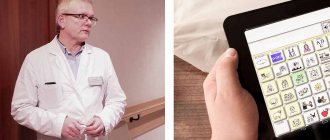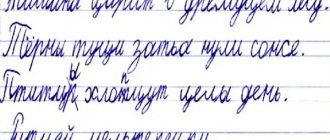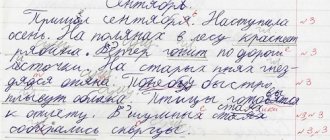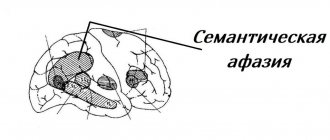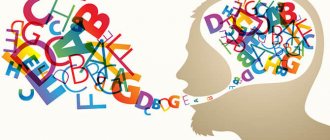Speech restoration program for afferent motor aphasia
Olga Trifonova
Speech restoration program for afferent motor aphasia
Aphasia is a complete or partial loss of speech caused by local damage to the cerebral cortex, leading to disintegration of the entire mental sphere of a person.
The cause of aphasia in adults is cerebral stroke (40-50% of pathologies)
.
Childhood aphasia is rare and is more common in boys (less than 1%)
. In most cases, such conditions are diagnosed against the background of open craniocerebral injuries and pathology of the vessels supplying blood to the brain - the internal carotid or middle cerebral artery. Tumors, aneurysms, hematomas, brain abscesses, encephalitis, and epilepsy also act as etiological factors.
To develop a speech rehabilitation program for aphasia , it is necessary to correctly classify the speech disorder.
There are 6 types of aphasia .
In case of damage to the temporal parts of the CGM (Wernicke's area)
Acoustic-gnostic and acoustic-mnestic forms
of speech .
The patient ceases to understand speech addressed to him, and as a result of a violation of auditory control, he develops profuse unproductive speech, and the process of verbal communication as a whole becomes inaccessible. Damage to the parietal parts of the CGM leads to apraxia of the organs of articulation, i.e. difficulty in finding the correct position of these organs in order to pronounce a speech sound and mentally pronounce a word . The syllabic and sound-letter structure of the word is disrupted ( afferent motor aphasia )
;
understanding of logical and grammatical phrases, the figurative meaning of words and the semantics of speech in general , acalculia, violation of the body diagram (semantic
aphasia ) .
Circulatory disorders in the frontal lobes of the CGM (Broca's area)
lead to difficulty switching from one articulatory act to another;
the kinetic motor program . In most cases, patients are able to reproduce automated series and stable speech structures, in which the previous link associatively predetermines the subsequent one (
efferent-motor aphasia ) .
It is difficult to construct a phrase, the grammatical structuring of speech , and the expression of one’s own thoughts (dynamic
aphasia ) .
Treatment for aphasia after a stroke includes drug therapy to protect surviving cells from necrosis, nuchal translucency massage, physical therapy, and speech therapy. The duration of rehabilitation depends on the degree of brain damage. Full recovery may take several months or several years.
Classes with a speech therapist should begin as early as possible, no later than two weeks from the onset of the first symptoms.
speech restoration classes should be about 7-15 minutes, since the patient’s condition requires rest. Gradually the duration can be increased.
Restoring speech after a stroke is a complex and lengthy matter; its success largely depends on the efforts of the patient and his psychological mood. A speech therapist needs to be a good psychologist. People who have had a stroke often feel hopeless. They are very sensitive to carelessly thrown words and have a hard time dealing with failures. A meeting with an unfriendly specialist who is unable to create an optimistic mood can be fatal for a person with a speech impairment. He will withdraw into himself and lose faith in recovery. Help from relatives, if not provided correctly, can also slow down the healing process.
With a diagnosis of afferent motor aphasia, it is impossible to reproduce speech while maintaining an understanding of the meaning of addressed speech . There is paralysis of the right (or left)
sides of the body;
on the face there is asymmetry of nasolabial folds, difficulties in the movement of the jaws, eyelids, and facial muscles. Writing and reading are unavailable or inconsistent. The primary disorder in aphasia of this form is apraxia of the organs of articulation, that is, difficulties in finding the correct position of these organs in order to pronounce a speech sound and mentally pronounce a word .
The syllabic and sound-letter structure of the word is disrupted. SPEECH RESTORATION PROGRAM FOR AFFERENT MOTOR APHASAIA .
In the recovery , the main support is the availability of involuntary speech due to the direct connection of these areas of the cerebral cortex with the subcortical sections. That is why recovery comes from involuntary
level to arbitrary.
Stage 1 (2 - 4 weeks, duration of classes 10-30 minutes 3 times a week)
.
Restoration of oral praxis (combined with professional, medical massage of the whole body)
:
— probe massage of the organs of articulation;
— facial gymnastics (first with the help of a speech therapist, then independently)
;
— finger gymnastics (first with the help of a speech therapist, then independently kneading the fingers with a healthy hand);
— breathing exercises (formation of speech breathing)
;
- onomatopoeia;
— psychological conversations with an explanation of the mechanism of the disease, the plan for working on the disease.
Result: the patient independently, voluntarily opens and closes his mouth and eyes; pronounces the vowel sounds A, U, E, O, I with the help of a speech therapist in the formation of articulatory postures; inflates a balloon; pronounces sound and syllabic onomatopoeia (except for syllables with consonants)
.
Stage 2 (2 - 4 weeks, duration of classes 30 minutes 3 times a week)
.
Disinhibition of speech functions based on old speech stereotypes with clapping of the speech rhythm (the speech therapist begins, the patient continues or finishes)
:
- counting, naming months, seasons, days of the week;
- finishing familiar phrases, proverbs, sayings;
- singing familiar songs;
- reciting familiar poems;
— psychological conversations about the need for constant training, not only in the process of rehabilitation exercises, concentration of willpower.
Result: the patient, with the help and independently, reproduces familiar lyrics of songs, poems, “winged”
expressions, involuntarily
(randomly and not always)
answers questions with words.
Stage 3 (several months or years, duration of classes 30 - 40 minutes 1 - 2 times a week). Work on the arbitrariness of speech utterance:
- arbitrary reading of 1 vowel letter; combinations of 2 - 3 - 4 vowels;
- reading and laying out cards with the given 1 - 2 - 3 letters;
- random reading of words of 2 - 3 - 4 letters;
- arbitrary reproduction of words (nouns, verbs)
from 1 - 2 - 3 syllables with the same, different vowels;
- independent choice of answer from a question like: do you want porridge or borscht? (- Porridge)
;
- formation of the syllabic structure of words 1 (2 — 14)
type;
- analysis of the vowel in 1 - complex words like: CAT, HOUSE;
- finishing a syllable in words: boom (ga, conf (ta)
;
— psychological conversations about the need to continue the fight against the disease.
Result: the patient voluntarily reads a vowel, a combination of vowel letters (from 1 to 4), uses cards to lay out a given sequence of vowel letters; selects a word from a question to answer. But these achievements are not constant: there are difficulties in finding the correct position of the articulatory organs for the purpose pronouncing a speech sound or sounds; the patient confuses letters, often finishing words only when prompted by the first syllable.
It is important to continue speech therapy correction, to have an emotional positive influence on the patient, because due to a depressive mood due to the lack of rapid dynamics of speech restoration, the patient may lose faith in the possibility of rehabilitation and refuse classes.
What is dynamic aphasia?
Dynamic aphasia is a local absence or disturbance of already formed speech due to the inability to form internal speech and express it. Most often it occurs as a result of damage to the prefrontal region of the left hemisphere in right-handed people and vice versa, that is, the departments of the third functional block - activation, regulation and planning of speech function.
Dynamic aphasia syndrome was first discovered in the middle of the last century in 1934 by physician and researcher Karl Kleist. He put forward the hypothesis that with this type of aphasia there is a violation of the formation of spontaneous speech. Later, A.R. became interested in this topic. Luria, who in turn suggested that despite the impairment of developed spontaneous speech, the motor and sensory components are preserved in the victim.
The dynamic form of aphasia is characterized by a violation of the formation of written and oral active speech; difficulties arise in perceiving some information and performing certain thought processes. At the same time, patients with such forms of aphasia are not able to independently construct a sentence and have difficulty in correctly constructing words, which leads to a large number of grammatical errors. It is difficult for such people to perceive verbs and carry out any commands and actions.
Efferent motor aphasia - tasks
Speech restoration techniques.
Speech restoration techniques are also being developed based on taking into account a number of features of aphasic disorders.
Based on the predominance of neurodynamic or organic disorders in the picture of speech disorder, a stage-by-stage principle for organizing rehabilitation training for patients with aphasia was put forward. But at the initial stages of remedial training, the principle of differentiation of methodological techniques depending on the form of aphasia is less important than at subsequent stages.
Thus, work to revive the sense of language can begin already in the early stages of rehabilitation training, when the patient still has virtually no phrasal speech, but there are various neurodynamic disorders in the form of decreased mental activity, criticism of one’s condition, exhaustion of attention, and there are motor disorders such as right-sided hemiparesis, up to plegia, which aggravates the difficulties of recovery work.
A peculiarity of work in the early stages is that, with certain modifications, some methodological techniques can also serve the purposes of prevention. Thanks to this, it is often possible to prevent the occurrence and fixation of agrammatism in aphasia.
Thus, even at the stage of pronounced neurodynamic and speech disorders in patients with a predominance of motor aphasia, when one of the main tasks is to restore understanding of situational and everyday speech, patients are offered to show pictures depicting actions (sitting, standing, running, etc.) or pictures of objects with a proposal to show them by action (what they use to dig the ground, what they write with, what they use to hammer nails). Taking into account the decrease in mental activity and exhaustion of attention, the patient is given a limited number of pictures (at the beginning of work 2-3), gradually increasing their number. Here you can use not only demonstration, but also, if possible, naming the action; if necessary, use repeated and conjugate speech, as the most preserved types of speech in patients with anterior lesions of the speech zone of the brain. The same technique can be used when laying out captions under pictures.
In order to move on to composing sentences, the patient is first asked to divide the sentence into words (for example: “the weather is good today”). It is better to do this without writing this sentence, but first lay it out from the letters of the split alphabet, so that the patient has options for completing the task, because letters can be moved freely without fear of making a mistake.
When the patient begins to correctly identify individual words, he is given the task of composing sentences of a certain model and, to begin with, the words are written on separate cards for a more free combination of these words and a sample is given. First, very simple sentences are given (a girl reads a book; students take exams; a cow gives milk). Then the sentences are complicated, prepositions are introduced; the task is given to compose 2 sentences from the same words (direct and reverse word order) to overcome perseverations, for example:
- The plane flies over the sea.
- An airplane flies over the sea.
This task already presents some difficulties for patients with damage to the anterior parts of the speech zones due to decreased activity and inertia.
As the sense of language is revived and grammatical structure is restored, patients are asked to compose longer and more complex sentences from individual words. But first, sentences of a certain structure are given, with a sample presented and words written on separate cards, for example:
- The guys let the bird out of the cage.
- We bought theater tickets.
- I love pancakes with sour cream.
Then sentences with several prepositions are given, for example:
- The children were walking with their grandmother in the park.
- We took a boat ride on the lake.
- The housewife goes to the store for groceries.
Patients often find it difficult to write sentences like:
- A crow sits on a tree branch.
- The guys are sunbathing on the river bank.
- We approached the trolleybus stop.
The card system also helps here.
With further recovery, patients are given longer sentences of various models without a sample, as well as the task of making sentences from individual words in the whole story. For example, make up sentences in the story “Who wrote what?”:
Papers were, in, not, distant times. Manuscripts, tablets, on, first, clay, first, appeared. They wrote on metal, then. Paper, bone, in the, ivory, east, replaced. Letters, used, animals, for, skin, often. There are many books that have survived. In Rus', in, on, the ancient, birch bark, they wrote.
While the patient does not have phrasal speech and various neurodynamic disorders are present, it is better to give patients ready-made forms , that is, do not allow them to fill in the missing endings, but insert the same word with different endings into short sentences of frequently used models:
- This … .
- I have no … .
- Give me … .
- I drink tea from...
- I admire the beautiful...
- Cup, cup, cup, cups.
For clarity, you can accompany this exercise with a drawing of an object, and also write these words on cards so that the patient can insert one word or another. The speech therapist reads the composed sentence out loud, that is, the patient evaluates the correctness of the construction presented aurally and in writing.
You can also work with other parts of speech; working with verbs .
First, verbs are given only in the singular or plural or in different numbers of one person in order to have fewer options to choose from, which is especially important for patients with severe neurodynamic disorders.
For example:
He... a song. You... a song. I... a song. She... a song. Sing, sing, sing. You...song. They... a song. We... a song. Sing, sing, sing.
Then a verb is given, for example “read”, in various numbers and persons:
- You... this book? - No, we all... this magazine, and I... the newspaper. - Are you... a textbook? - Yes, I... a textbook.
Girl... book. Boy... magazine.
I read, read, read, read, read, read.
You can give the patient a task to fill in the missing endings and prepositions, at first no more than 2-3.
For example, insert the missing endings of nouns “e” or “y”:
We are studying at college. . There was a delay at the airport. . It's good to relax by the sea. . A worker works at a factory. . To the snow. traces are visible. On the floor. a carpet has been laid. On the walls. a picture hangs.
Insert the missing prepositions: in, on, by.
... there are a lot of mushrooms in the forest. We walked... in the forest. We walked... along a beautiful path. We stopped right... on the path. The squirrel lives... in a hollow. The squirrel jumps... to the branches. A squirrel sits... on a branch. The cat is running... into the yard. Children play... in the sandbox. Grandmothers are sitting... on a bench.
These techniques can also be used in rehabilitation training with patients with sensory and acoustic-mnestic aphasia.
Types and forms of speech disorders
R. Jacobson proposed to distinguish between two types of speech disorders.
- In one of them, the leading place is occupied by defects in paradigmatic operations, in other words, the assimilation of those language codes that include mutually preparing relations.
- In another type of violation, the leading place is occupied by defects in syntagmatic processes, that is, units of smooth contextual utterance.
When the anterior speech zones of the left hemisphere are damaged, the leading place is occupied by defects in syntagmatic connections.
Speech defects in these patients manifest themselves in different ways: in some, expressive speech becomes completely impossible, in others it loses its active character and the patient, who correctly repeats words and sentences, is unable to independently formulate a detailed statement; in others, the defect takes the form of a “telegraphic speech”. style”, in which all predicates and connectives drop out of the patient’s speech, while the communicative components remain intact. What these patients have in common is a gross impairment of coherent, intonationally expressive speech.
In dynamic aphasia, the lesions are located in the anterior parts of the speech zone of the left hemisphere and disturbances that are specifically speech in nature are observed. The central symptom for this group of patients is a pronounced impairment of spontaneous expanded speech, up to its virtual absence. Speech disorders here affect those deep levels of organization of speech processes that relate to the formation of internal speech and extend to the levels of semantic recording and deep syntactic structures. Speech disorders in these patients are not accompanied by gross agrammatism, but there is a tendency to reduce complex syntactic structures to more elementary constructions. Probably, the main violation in the correct formation of an independent statement is located in these patients at the level of formation of the semantic scheme of the statement and relates to the shortcomings of internal speech.
Another form of speech disorders has significantly different features, in which not so much the general programming of the utterance is disrupted as its grammatical structure. This group of patients does not have a pronounced defect in the semantic scheme of the message. The difficulties encountered here move much closer to the surface syntactic structure of the utterance, and the encoding of the speech message begins to clearly suffer in the most basic syntactic links. The predicative part of the sentence is either omitted, or the number of verb forms is simply reduced, the proportion of nouns increases, mainly in the nominative case, conjunctions and prepositions are omitted. This fact indicates a gross breakdown of surface-syntactic structures as the main speech defect of the patient.
However, violations of the encoding of active utterances are not always of such a specific nature. Much more often in practice there are cases when violations of statements are more severe and complex in nature and when general inactivity and inertia of nervous processes are combined with specifically speech disorders of message coding. In these cases, we observe a picture with a predominance of gross motor aphasia, leading to a complex breakdown of speech activity. This is especially often noted in the initial stages of rehabilitation training.
It should be noted that in patients with damage to the anterior parts of the brain, along with defects in expressive speech, speech understanding is also impaired. In addition to narrowing the meanings of words and impaired understanding of verb words, patients in this group have impaired understanding of sentences, since the patient ignores grammatical indicators. Patients correctly understand the content of sentences with direct word order (the boy drew a house), but there are significant difficulties in understanding sentences with reverse word order (the house was drawn by a boy), as well as sentences where the grammatical factor is important for understanding (for example, the patient finds it difficult to complete the task “show a pen with a pencil” - patients alternately show a pencil and a pen).
In addition, patients with damage to the anterior parts of the brain do not always notice errors in incorrect syntactic structures. The sentences “The cat is sitting under the table” and “The cat is sitting under the table (table)” sound the same to them. In understanding speech, they rely on the meaning of words, and not on the grammatical factor.
It is necessary to point out such a phenomenon in case of lesions of the anterior sections of the speech zone of the brain as a violation of the sense of language, which is expressed in the absence or impairment of the control function, assessing the correctness of the linguistic phenomenon, the correspondence of the form of an utterance to its content. Thus, when assessing the correctness of a proposal, one often hears from patients: “I don’t know, I don’t feel it, this way or that way.”
Apparently, a violation of the grammatical formalization of speech in patients with aphasia is associated with defects in the sense of language due to the destruction of dynamic stereotypes that underlie the process of grammatical formation of an utterance. Disautomation of speech processes is one of the main properties of aphasia.
Turning off any of the speech mechanisms leads to the collapse of the entire dynamic stereotype that controls this type of speech. These disorders manifest themselves most severely in efferent motor aphasia.
Classification
Currently, there are a large number of different classifications of aphasia. In the Russian Federation, the classification most often used is A.R. Luria, which reflects all clinical types of aphasia:
- Efferent motor aphasia, this form occurs in case of damage to the lower parts of the cortex - Broca's center. It is characterized by the collapse of grammatical structures into sentences and the difficulty of restructuring from one word to another. Serious reading and writing impairments occur.
- Afferent motor aphasia. Occurs when an area of the parietal cortex or posterior area is affected. The key disorder in this aphasia is the inability to detect the necessary articulatory position of the lips, tongue and speech facial muscles for the correct pronunciation of a word.
- Dynamic aphasia - occurs when the prefrontal or perifrontal part of the cerebral cortex is damaged. It is manifested by the lack of possibility of adequate construction of internal speech and its implementation aurally.
- Semantic aphasia - it is based on a defect in understanding complex speech structures and simultaneous analysis of information.
Causes of dynamic aphasia
The formation of the pathological process is based on a disruption in the functioning of cortical structures in the region of the speech center of the brain. In the case of dynamic aphasia, patients suffer damage to the posterior frontal parts of the left hemisphere - in a place located in close proximity to Broca's area. This fact influences the characteristics of the manifestation of this form of aphasia - a decrease in spoken speech. The patient’s speech becomes “poor”, verbs are missing or skipped, and the patient requires stimulating questions.
There are quite a large number of risk factors, the main ones of which include:
- Complicated family history;
- Elderly and senile age;
- Vascular diseases including atherosclerosis;
- Arterial hypertension;
- Rheumatic heart diseases;
- Mechanical injuries and surgical interventions on the brain.
Among the causes of aphasia, the primacy is occupied by vascular diseases of the brain - discirculatory encephalopathies, acute cerebrovascular accidents. In addition, aphasia is caused by inflammatory diseases (meningo-encephalitis, brain abscess), diseases of the central nervous system of a chronic course - Pick's disease, Alzheimer's disease, oncogenic diseases of a benign and malignant nature, traumatic brain injuries.
Treatment
First of all, you need to cure the underlying disease that caused the development of aphasia. To correct emerging symptoms, an integrated approach is used, including drug therapy, physiotherapeutic treatment, active rehabilitation, speech correction together with a speech therapist, as well as neuropsychological correction. Rehabilitation therapy should begin as early as possible, from the first days or weeks after the incident, as soon as the patient’s general condition allows. This is necessary to prevent the consolidation of pathological speech symptoms, the main of which are:
- Paraphasia is a speech disorder in which the logical structure of a sentence is disrupted and its semantic load is lost;
- Agrammatism is a difficulty in understanding sentences, especially those with complex syntax. Agrammatism occurs with a pathological focus localized in the Sylvian fissure;
At each stage of rehabilitation therapy, the joint work of the attending physician, psychologist, speech therapist, and especially the patient’s relatives is necessary. Only constant contact and communication will help achieve maximum effectiveness of treatment and rehabilitation procedures, as well as stabilize the patient’s general condition and mood. The speed of recovery processes and the mood in line with the patient’s wishes depend on how often and how much close and relatives communicate with the victim.
Drug therapy
Treatment of the underlying disease is carried out under the supervision of a neurologist or neurosurgeon. Drug therapy includes the following classes of drugs:
- Antioxidants and vitamins. These drugs are necessary to maintain a sufficiently active metabolic function of neurocytes. Antioxidants help accelerate regenerative and repair processes at the ultracellular level, stabilize cell membranes and protect them from lipid peroxidation. Among vitamins, a special role is played by B vitamins, which have a pronounced neuroprotective effect. B vitamins include: pyridoxine, pyrimidine, thiamine, folic acid, cyanocobalamin, riboflavin. Complex preparations of vitamins and antioxidants effective for dynamic aphasia include: Mexidol, Glycine (Lipoic acid), Aspirin, Emoxipin.
- Nootropic drugs. This group of drugs improves cerebral circulation and has a positive effect on metabolism in brain tissue. Nootropics have an antihypoxic and tranquilizing effect without inhibiting the activity of the central nervous system, which makes their use safe for everyday independent use. Taking nootropics is not accompanied by drowsiness, lethargy and relaxation of skeletal muscles. In addition, the drugs have a psychostimulating effect, restore mental performance and physical activity. This group of drugs includes all racetam derivatives (Piracetam, Nootropil), Picamelon, Cerebrolysin.
- Cerebroprotectors. Prescribed to prevent the development of complications and irreversible damage to neurocytes as a result of metabolic disorders or hypoxic shock, it affects metabolism, thereby improving blood supply to the brain. The main representatives are Vinpocetine, Cinnarizine, Coplamin.
- Vasoactive drugs - improve cerebral blood supply. This includes several different groups of drugs: antiplatelet agents (Clopidogrel, Plavix), anticoagulants (Sincumar, Warfarin, Heparin), calcium channel blockers (Nimodipine), methylxanthines (Pentoxtrental).
Speech therapy correction
The choice of a correctional work program primarily depends on the volume of the affected area of the brain and the severity of the clinical manifestations of dynamic aphasia. At the very beginning of rehabilitation, a restoration process is carried out, which begins with passive work with the patient, while methods are used to promote speech disinhibition and prevent the development of further speech disorders. Subsequently, the speech therapist draws up an individual plan and selects individual exercises for a particular patient. The duration of speech therapy correction for disorders associated with the development of aphasia averages about two to three years. The work uses special techniques for constructing sentences that allow the patient to reconstruct a detailed statement on his own. Work is also underway to correct the communicative function and self-control over it. Only when the patient understands the nature of his grammatical errors can one create opportunities for him to independently control his speech, the course of the narrative, and correct paraphasias.
The main emphasis of speech therapy work for dynamic aphasia is the elimination of defects in internal planning and programming of speech, as well as stimulation of speech activity.
Neuropsychic correction
Neuropsychological correction of speech in dynamic aphasia, regardless of the form of aphasia, deals with correction of all aspects of speech, namely its understanding, reproduction, writing and reading. The goal of neuropedagogical speech restoration for aphasia is to generally disinhibit speech, reduce the number of errors, improve the patient’s mental state and his interest in communication, as well as activity in general. The program plan is developed taking into account the individual characteristics of the lesion and the severity of the pathology. For this purpose, specific techniques are used, such as:
- “Having completed the mind” - the poem is read to the patient several times, after which the specialist begins the sentence, and the patient finishes it;
- Verbalization of one’s own actions - the patient is asked to talk about the progress of his day using drawing, reading and writing;
- Rhythmic-myological exercises – the patient learns light rhythmic songs, tongue twisters;
- Techniques of conjugate and reflected repetition;
- Semantic selection of words.
Physiotherapeutic treatment
Physiotherapy is prescribed in cases of traumatic brain injury, stroke and neurosurgery. The majority of patients are prescribed neuromyostimulation, which helps restore and strengthen the tone and strength of the facial muscles. Thanks to this method, myocytes are stimulated due to electric current pulses, which makes it possible to restore the lost motor function of the facial muscles.
Patients are also recommended to engage in physical therapy according to an individually drawn up plan together with a personal approach to each person. After physical therapy exercises, tissue metabolism and a wide variety of metabolic processes are activated in the body and cerebral blood flow increases. At the same time, the patient becomes more active and his mood improves.
Another significant means of physiotherapeutic treatment is therapeutic massage. Massage has a tonic, relaxing, antispasmodic effect, activates the excitability of the nervous system, and increases muscle performance.
